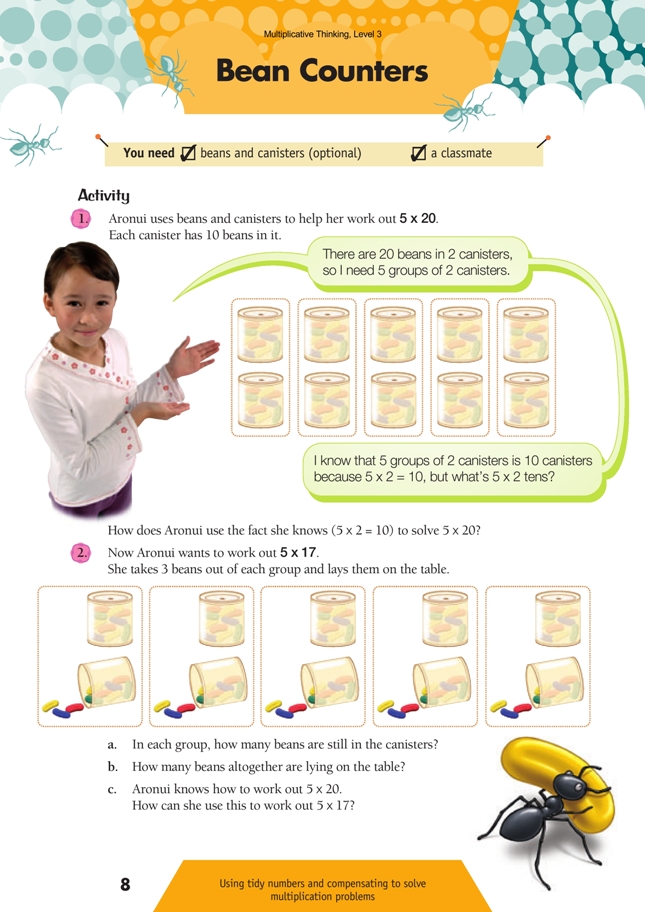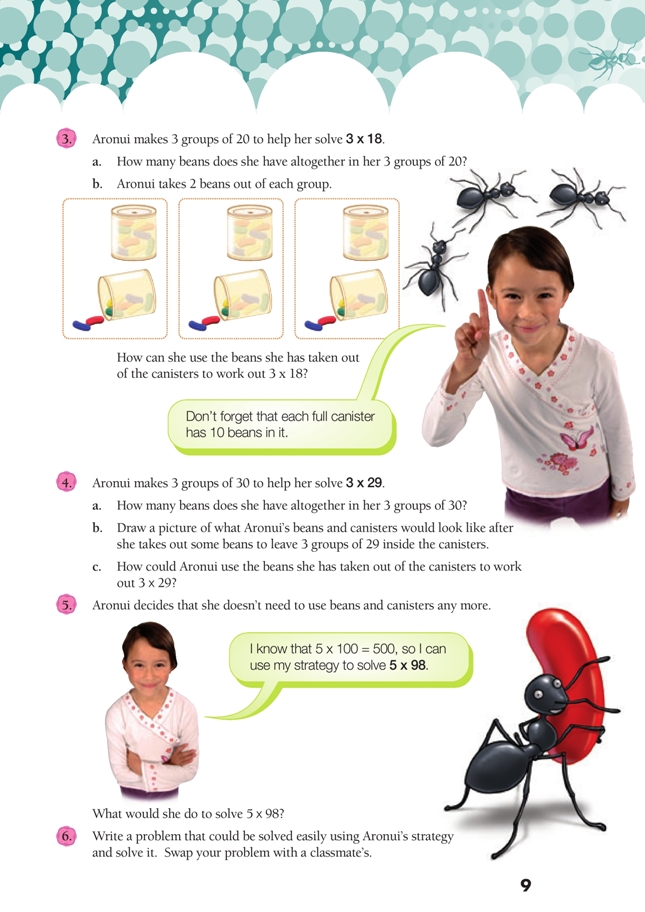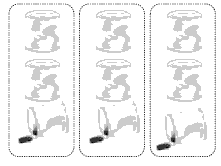Bean Counters
This is a level 4 number activity from the Figure It Out series. It relates to Stage 7 of the Number Framework.
A PDF of the student activity is included.
Click on the image to enlarge it. Click again to close. Download PDF (836 KB)
use tidy numbers to solve multiplication problems
Number Framework Links
Use this activity to promote the development of multiplicative part–whole strategies (stages 6–7) in the domain of multiplication and division. It is suitable for students transitioning to stages 6 or 7.
FIO, Level 3, Multiplicative Thinking, Bean Counters, pages 8-9
A classmate
In this activity, students solve multiplication problems by multiplying by a tidy number and then compensating. This strategy works well for problems where one of the two numbers involved is close to a tidy number, for example, 4 x 38 or 197 x 3. It’s easier to work out 4 x 40 than 4 x 38, but we must then compensate because we’ve got 4 groups of 2 more than we need. We compensate by subtracting the extras: 4 x 38 = (4 x 40) – (4 x 2)
= 160 – 8
= 152
It’s important that students can use a broad range of multiplicative strategies. They can then select the most efficient strategy for a particular problem rather than always relying on one familiar method. Encourage your students to use Aronui’s method as they work through the activity, even if they want to solve the questions in other (more familiar) ways. If they wish, they can use their existing strategies to check their answers. Once the students have acquired a number of strategies that they can use flexibly, they need to learn how to pick the one that will be most useful and efficient for a particular problem. You can help them develop this skill by getting them to discuss and compare different strategies and activities such as Multiple Multiplication Methods on pages 12–13.
This activity could be used as a guided teaching session with a group. Align it with the strategy teaching model from the NDP, encouraging your students to use materials, then imaging, and finally number properties. Alternatively, it could be used as an independent activity for complementing and following up the learning experiences covered in the NDP activities, A Little Bit More/A Little Bit Less, page 15, and Multiplication Smorgasbord, page 27, in Book 6: Teaching Multiplication and
Division.
When they encounter question 1, some students may not yet have made the connection between their basic facts and how they can be applied to multiples of 10. Emphasise this link by saying “2 tens” rather than “twenty” when discussing how the knowledge that 5 x 2 = 10 could be useful when working out 5 x 2 tens. The word “twenty” does of course mean “2 tens”, but this is not necessarily obvious. See the NDP links at the end of the notes for this activity for learning experiences
that help students decode English number words such as “-teen” and “-ty” (which both mean “ten”).
To promote generalisations, ask questions such as How does knowing 5 x 7 = 35 help you to work out 5 x 70 or 50 x 7 or 50 x 70? Have the students check their predictions on a calculator and talk about patterns they can see. Ask them to try to generalise a rule.
Encourage the students to manipulate place value materials to solve the problems in questions 2 and 3. Bundles of 10 iceblock sticks could be used in place of beans and canisters.
Promote imaging for question 4 by asking students to describe what they would do with the canisters to solve 3 x 29 using Aronui’s method. Expect responses such as: “I would have 3 groups of 3 canisters, so there would be 30 beans in each group. I’d take 1 bean out of each group and lay it on the table, leaving 29 beans in the canisters. To know how many beans I had to start with, I’d work out 3 x 3 tens is 9 tens, so I had 90 beans altogether. I took out 3 lots of 1 bean, or 3 beans.
90 beans take away 3 beans is 87 beans.” Go back to using materials if needed.
Use question 5 as a formative assessment opportunity to see if the students are able to use number properties to solve the problem using the tidy numbers and compensating strategy. Go back to imaging if needed by asking the students to describe what the materials would look like and what they would do with them to solve the problem.
Before the students write their own problems, talk about the sorts of numbers that this strategy is useful for in order to encourage them to see this strategy as one tool in their mental toolbox of strategies.
Ask them to compare the use of this strategy to solve the two problems 7 x 34 and 7 x 199.
Ask Why is this strategy easier to use with the second problem?
Look back at the problems in the activity and record them in a list: 5 x 17, 3 x 18, 3 x 29, 5 x 98.
Ask What is similar about all of these problems? (One of the numbers is a single digit, and the other one is close to a tidy number.)
Extension
Encourage the students to name the strategy with a descriptive name (such as using tidy numbers and compensating). Create a display that they can use as a reference by getting them to write in their own words the sorts of problems this strategy is most efficient for. Each time the group learns a new strategy, add it to the display, which can then be used to remind students of alternative strategies that they could try. In discussions, expect the students to justify the selection of a strategy to suit a particular problem.
The metaphor of a toolbox can be very useful. Write the name of each strategy on a picture of a tool, such as a hammer or a saw, and discuss how different tools (strategies) are suited to different situations and are able to be used in combination with each other to do a task. This metaphor can be used to justify the flexible use of a broad range of strategies: although you could probably do many jobs with a screwdriver if you really persisted (perhaps even banging in a nail), it’s much
more efficient to have a hammer when you need one.
Answers to Activity
1. Aronui knows that 20 is 2 tens (2 x 10 = 20). She uses 5 x 2 = 10 to work out 5 x 2 tens = 10 tens. 10 x 10 = 100, so 5 x 20 = 100.
2. a. 17. (20 – 3 = 17)
b. 15. (3 x 5 = 15)
c. Aronui knows that 5 x 20 = 100 beans. She took out 5 x 3 = 15 beans.
(5 x 20) – (5 x 3) = 100 – 15
= 85
So 5 x 17 = 85.
3. a. 60. (3 x 2 tens = 6 tens or 60 beans)
b. Aronui had 3 x 20 = 60 beans, and she took out 3 x 2 = 6 beans.
(3 x 20) – (3 x 2) = 60 – 6
= 54
So 3 x 18 = 54.
4. a. 90. (3 x 3 tens = 9 tens or 90 beans)
b. A possible picture is:
c. Aronui had 3 x 30 = 90 beans, and she took out 3 x 1 = 3 beans.
(3 x 30) – (3 x 1) = 90 – 3 = 87
So 3 x 29 = 87.
5. 5 x 98 = (5 x 100) – (5 x 2)
= 500 – 10
= 490
6. Problems will vary. One of the numbers in the problem should be a single digit and the other close to (but just a little bit less than) a tidy number. Some examples are: 3 x 68 = , 5 x 77 = , 6 x 999 = . Check your answer with a calculator before you give it to your classmate.


